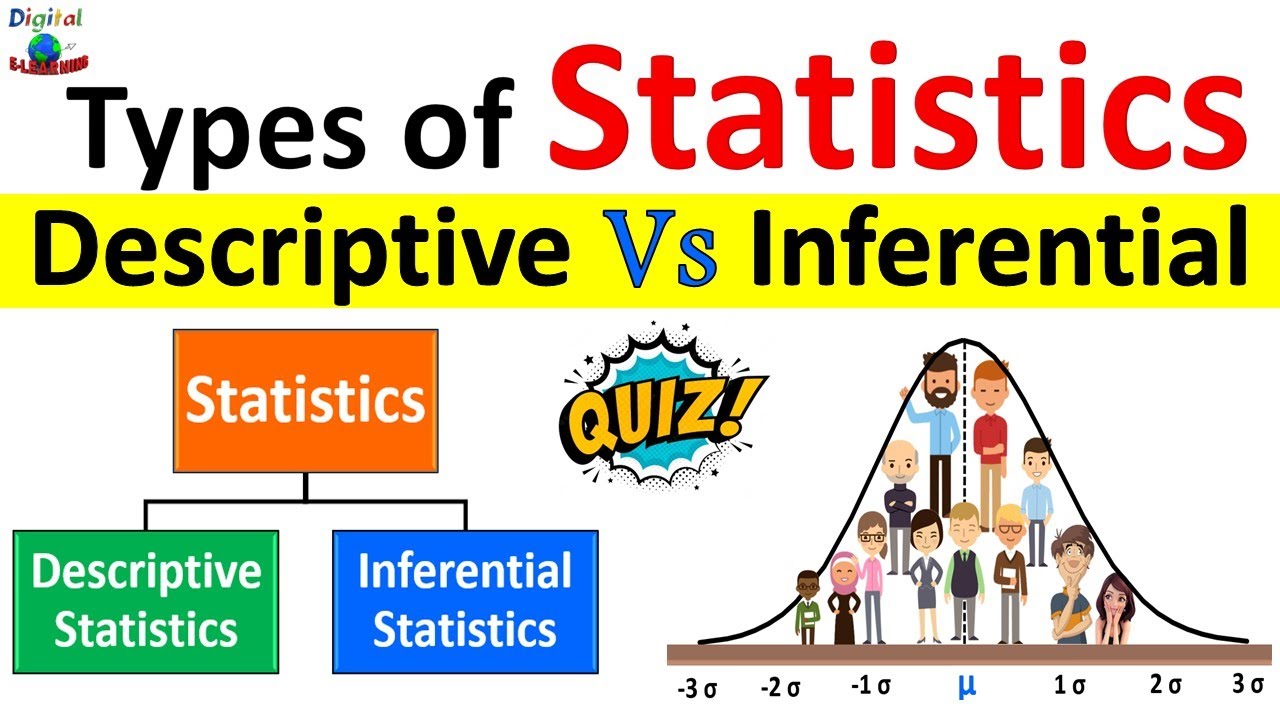Difference between Descriptive and Inferential Statistics | Descriptive vs Inferential 5Minutes Info
TLDRIn this informative episode, the host introduces viewers to the world of statistics, explaining its role in data analysis. The episode delves into descriptive statistics, focusing on summarizing and presenting data, and inferential statistics, which predict and infer patterns within populations. Highlighting the differences in scope, objectives, and methodologies, the host also discusses the tools and software used in each branch, concluding with the impact of each on understanding and predicting data trends.
Takeaways
- 📚 Statistics is a branch of mathematics that deals with the collection, analysis, interpretation, and representation of data, as well as hypothesis testing, probability, and estimation.
- 📊 Descriptive statistics is a branch that focuses on summarizing, organizing, and presenting data in a meaningful way to describe and analyze the main features and characteristics of a dataset.
- 🔮 Inferential statistics is a branch that helps researchers make predictions and inferences about a population based on sample data, identifying patterns and trends.
- 🔍 The main difference between descriptive and inferential statistics lies in their scope: descriptive focuses on summarizing data, while inferential makes predictions and inferences about the population.
- 🎯 Descriptive statistics aim to present data, whereas inferential statistics aim to predict future outcomes based on the data.
- 📈 Descriptive statistics are used to explore and understand the main features of a dataset, including organizing, summarizing, interpreting, and classifying data.
- 🔢 Inferential statistics involve drawing conclusions, making predictions, estimating, comparing, and determining cause-and-effect relationships, as well as hypothesis testing.
- 🛠️ Descriptive statistics use measures of central tendency, dispersion, and frequency distribution, while inferential statistics employ hypothesis testing and regression analysis.
- 📊 Descriptive statistics can be easily understood and calculated using a calculator or spreadsheet, whereas inferential statistics require learning complex statistical methods and often software like SPSS, Minitab, or PSPP.
- 📈 Descriptive statistics are presented in graphs, charts, or tables, while inferential statistics present probability estimations, scores, and hypothesis testing results.
- 🔑 Descriptive statistics results are confined to the data itself and do not extend beyond it, whereas inferential statistics results help to generalize findings to a larger population.
Q & A
What is the main focus of the video script?
-The video script focuses on explaining the concept of statistics, specifically breaking down into descriptive and inferential statistics, and highlighting the differences between the two.
What are the four main points discussed in the video?
-The four main points discussed are: 1) Definition of statistics, 2) Descriptive statistics, 3) Inferential statistics, and 4) Differences between descriptive and inferential statistics.
What is the definition of statistics as per the script?
-Statistics is defined as a branch of mathematics that deals with the collection, analysis, interpretation, explanation, and representation of data, as well as hypothesis testing, probability, and estimation.
What is the purpose of descriptive statistics?
-Descriptive statistics aims to summarize, organize, and present data in a meaningful way, focusing on describing and analyzing the main features and characteristics of a dataset.
How does inferential statistics differ from descriptive statistics?
-Inferential statistics helps researchers to make predictions and inferences about a population based on the research data, identifying patterns and trends, unlike descriptive statistics which focus on summarizing and describing the data.
What are the main objectives of inferential statistics?
-The main objectives of inferential statistics are to draw conclusions, make predictions, estimate, compare, and determine cause-and-effect relationships, as well as test hypotheses.
What tools or methods are commonly used in descriptive statistics?
-Descriptive statistics commonly use measures of central tendency, dispersion, and frequency distribution.
What are the typical applications of inferential statistics?
-Inferential statistics are used to predict chances and possibilities of future directions based on existing situations and to generalize findings to a larger population.
What software might be needed for inferential statistics?
-Software like SPSS, Minitab, STAT, and PSPP may be needed for complex methodology and analysis in inferential statistics.
How are the results of descriptive statistics presented?
-Descriptive statistics results are typically presented in the form of graphs, charts, or tables.
How do the results of inferential statistics differ from those of descriptive statistics?
-While descriptive statistics results describe calculations within the data and do not extend beyond the data itself, inferential statistics results help to generalize findings to a larger population.
Outlines
📊 Introduction to Statistics and Its Types
This paragraph introduces the audience to the concept of statistics as a branch of mathematics, focusing on the collection, analysis, interpretation, and representation of data, as well as hypothesis testing, probability, and estimation. It outlines the two main types of statistics: descriptive and inferential. Descriptive statistics is defined as the summarization and organization of data to present its main features, while inferential statistics is about making predictions and inferences based on research data to identify patterns and trends within a population. The paragraph also mentions guidance on where to find notes for the video lecture.
📈 Differences Between Descriptive and Inferential Statistics
This paragraph delves into the distinctions between descriptive and inferential statistics. Descriptive statistics is concerned with summarizing and describing data, utilizing measures such as central tendency, dispersion, and frequency distribution, and is presented in graphs, charts, or tables. In contrast, inferential statistics aims to make predictions and inferences about the population, using complex methodologies like hypothesis testing and regression analysis, and often requires statistical software. The results of descriptive statistics are confined to the data at hand, whereas inferential statistics generalize findings to a larger population. The paragraph concludes by inviting viewers to connect on social media for further queries and promises more informative episodes in the future.
Mindmap
Keywords
💡Statistics
💡Descriptive Statistics
💡Inferential Statistics
💡Data
💡Hypothesis Testing
💡Estimation
💡Central Tendency
💡Dispersion
💡Frequency Distribution
💡Regression Analysis
💡Generalization
Highlights
Statistics is a branch of mathematics that involves the collection, analysis, interpretation, explanation, and representation of data, as well as hypothesis testing, and estimation.
There are two main types of statistics: descriptive statistics and inferential statistics.
Descriptive statistics is a branch that involves summarizing, organizing, and presenting data in a meaningful way, focusing on describing and analyzing the main features and characteristics of a dataset.
Inferential statistics helps researchers draw inferences or make predictions based on research data, enabling them to identify patterns and trends about large data or a specific population.
The difference between descriptive and inferential statistics includes the scope of the sample, objectives, dimensions, applications, tool usage, understanding, presentation, and results.
Descriptive statistics summarize and describe data, while inferential statistics make predictions and inferences about the population.
Descriptive statistics are concerned with the presentation of data, whereas inferential statistics are concerned with future production.
Descriptive statistics are used to explore and understand the main features of a dataset, while inferential statistics draw conclusions, make predictions, estimate, compare, and determine cause and effect relationships and hypothesis testing.
Descriptive statistics describe the existing or current situation, while inferential statistics predict the chances and possibilities of future directions based on the existing situation.
Descriptive statistics measure central tendency, measure of dispersion, and frequency distribution, while inferential statistics use hypothesis testing and regression analysis.
Descriptive statistics data can be easily understood and calculated on a calculator or Excel spreadsheet, while inferential statistics require learning statistical methods and complex methodology.
Inferential statistics often need software like SPSS, Minitab, STA, and PSPP to present.
Descriptive statistics are presented in the shape of graphs, charts, or tables, while inferential statistics present probability estimation scores and hypothesis testing.
Descriptive statistics results describe the calculation of data and never go beyond the data, while inferential statistics results help to generalize findings to a large population.
The video lecture notes can be found in the link mentioned in the video description.
The episode concludes with a discussion on the four points: what is statistics, what is descriptive statistics, what is inferential statistics, and the differences between descriptive and inferential statistics.
Transcripts
Browse More Related Video

What is Statistics? | Types of Statistics | Descriptive & Inferential Statistics | Acadgild

Introduction to Statistics (1.1)

Descriptive Statistics: FULL Tutorial - Mean, Median, Mode, Variance & SD (With Examples)

Elementary Stats Lesson #1

Descriptive Statistics vs Inferential Statistics | Measure of Central Tendency | Types of Statistics

What is Descriptive Vs. Inferential Statistics?
5.0 / 5 (0 votes)
Thanks for rating: